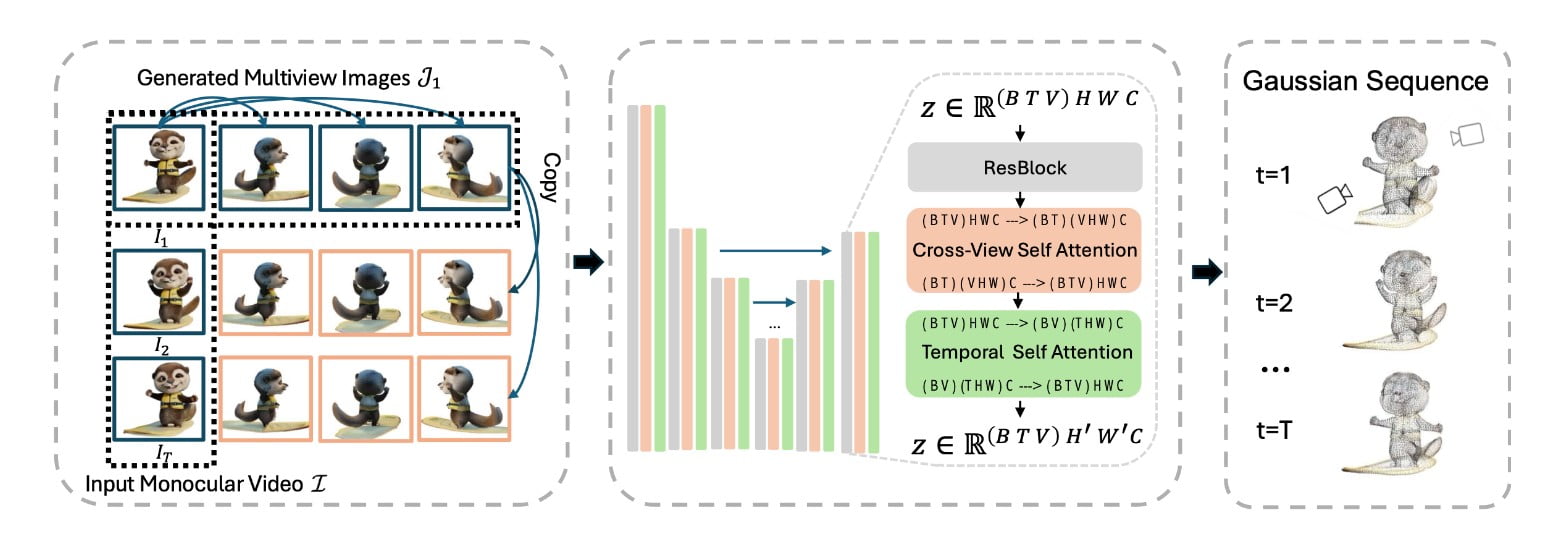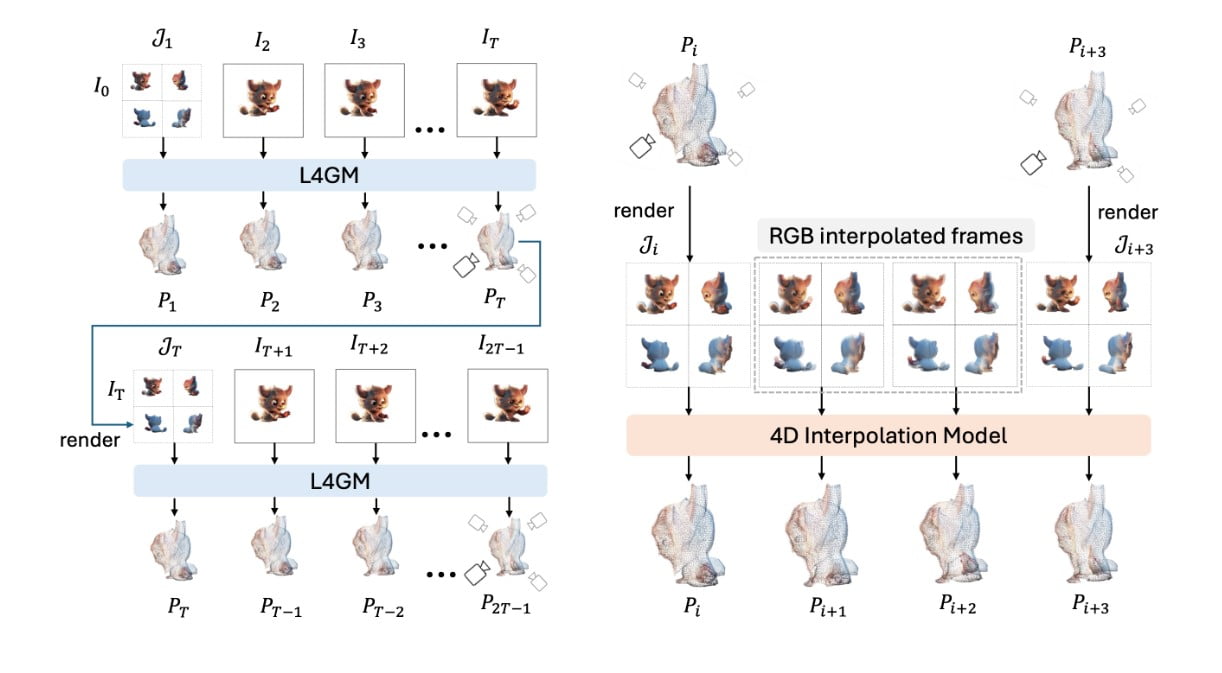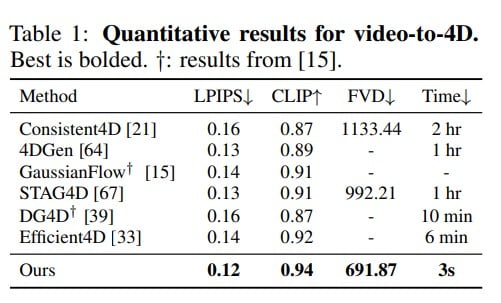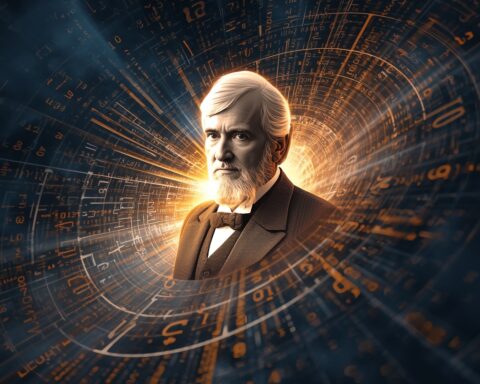Last Updated on June 27, 2024 9:43 am by Laszlo Szabo / NowadAIs | Published on June 27, 2024 by Laszlo Szabo / NowadAIs
Nvidia’s L4GM: Animated Objects from Video Input in Seconds – Key Notes
- Nvidia’s L4GM stands for Large 4D Gaussian Reconstruction Model.
- Integrates 3D reconstruction with 4D modeling for dynamic digital content.
- Generates 4D animated assets from single-view videos in seconds.
- Utilizes a vast dataset called Objaverse for training.
- Potential applications in entertainment, engineering, VR, AR, and robotics.
- Developed by Nvidia, University of Toronto, and other institutions.
- Focus on high-quality, seamless temporal dynamics in 4D models.
Nvidia’s L4GM System: 3D Reconstruction in Seconds
The world of computer vision and graphics is abuzz with the arrival of a game-changing technology – Nvidia’s Large 4D Gaussian Reconstruction Model, or L4GM for short. This new system promises to transform the way we create and interact with dynamic, three-dimensional digital content, ushering in a new era of immersive experiences.
At the heart of L4GM lies a novel approach that seamlessly blends advancements in large-scale 3D reconstruction with the temporal dynamics of 4D modeling. By leveraging a curated dataset of high-quality, multi-view animated objects, the researchers behind L4GM have developed a model capable of generating animated 3D assets from a single-view video input, all within a matter of seconds.
In this article, we’ll delve into the technical intricacies of L4GM, explore its capabilities, and uncover the potential impact it may have on industries ranging from entertainment to engineering. Prepare to be amazed as we unravel the secrets behind this AI technology!
The Emergence of L4GM
The world of computer vision and graphics has long grappled with the challenge of accurately capturing and recreating the dynamic nature of our three-dimensional universe. Traditional methods have often fallen short, requiring laborious manual modeling or complex, resource-intensive video processing pipelines.
Enter Nvidia’s L4GM, a new solution that seeks to change the landscape of 4D content generation. Developed by a team of renowned researchers from Nvidia, the University of Toronto, and other prestigious institutions, L4GM leverages the power of large-scale 3D reconstruction models to tackle this long-standing problem.
At the core of L4GM is the recognition that the key to unlocking the potential of 4D lies in the seamless integration of static 3D geometry and dynamic temporal information. By building upon the success of Nvidia’s Large Gaussian Model (LGM), a state-of-the-art 3D reconstruction system, the L4GM team has developed a novel approach that extends these capabilities into the fourth dimension.
The L4GM Architecture: Unifying 3D and 4D

The L4GM architecture is a masterful blend of cutting-edge techniques, drawing inspiration from the latest advancements in 3D reconstruction, temporal dynamics, and generative modeling. Let’s delve into the key components that make this system so groundbreaking:
3D Reconstruction Foundation
At the core of L4GM is the LGM, Nvidia’s pretrained 3D Large Reconstruction Model. This powerful system is capable of generating high-quality 3D Gaussian ellipsoids from multi-view image input, laying the foundation for L4GM’s ability to capture the static geometry of objects and scenes.
4D Temporal Dynamics
To introduce the temporal dimension, the L4GM team has incorporated a series of temporal self-attention layers into the base LGM architecture. These layers enable the model to learn consistency and coherence across time, ensuring that the generated 4D content exhibits smooth and natural motion.
Gaussian Splatting Representation
L4GM represents the 4D content using a per-frame 3D Gaussian Splatting approach. This efficient representation allows the model to capture the spatial and temporal details of the animated objects, while also enabling a high-framerate upsampling process to achieve temporal smoothness.
Multiview Rendering Loss
To further enhance the quality and consistency of the 4D output, the L4GM training process utilizes a per-timestep multiview rendering loss. This loss function ensures that the generated Gaussian representations faithfully capture the object’s appearance from multiple viewpoints, resulting in a more realistic and cohesive 4D reconstruction.
4D Interpolation Model

The final piece of the L4GM puzzle is an interpolation model that takes the low-framerate Gaussian representations and upsamples them to a higher framerate. This step introduces additional temporal smoothing, producing the final high-quality animated 3D assets.
The L4GM Dataset: Fueling Innovation
The success of L4GM can be largely attributed to the novel dataset of multi-view animated objects that the researchers have curated. Dubbed the “Objaverse,” this comprehensive collection features 44,000 diverse objects with 110,000 unique animations, all rendered from 48 different viewpoints.
“Key to our success is a novel dataset of multiview videos containing curated, rendered animated objects from Objaverse”
– Nvidia stated.
This dataset, comprising a staggering 12 million videos and a total of 300 million frames, provides the L4GM model with a rich and diverse training corpus. By exposing the system to such a vast array of animated content, the researchers have enabled L4GM to learn the intricate patterns and nuances of 4D object dynamics, allowing it to generalize remarkably well to in-the-wild video inputs.
Capabilities and Applications of L4GM

The capabilities of Nvidia’s L4GM extend far beyond mere technical prowess. This groundbreaking system has the potential to revolutionize a wide range of industries and applications, from entertainment to engineering and beyond.
Video-to-4D Synthesis
One of the most impressive features of L4GM is its ability to generate high-quality 4D animated content from a single-view video input. In a matter of seconds, the model can transform a simple video into a fully animated 3D asset, complete with realistic motion and temporal dynamics.
Reconstructing Long, High-FPS, In-the-Wild Videos
L4GM’s capabilities are not limited to short video clips. The system can also handle longer, high-framerate videos captured in uncontrolled environments, known as “in-the-wild” footage. By seamlessly integrating the 3D reconstruction and temporal dynamics, L4GM can produce detailed 4D reconstructions from these challenging inputs.
4D Interpolation
In addition to generating 4D content from scratch, L4GM also offers a powerful 4D interpolation model. This component can take low-framerate 4D representations and intelligently interpolate them to create higher-framerate animations, further enhancing the temporal smoothness and visual fidelity of the output.
Diverse Applications
The versatility of L4GM opens up a world of possibilities. This technology can revolutionize the entertainment industry, enabling the rapid creation of high-quality animated characters and environments for films, games, and virtual reality experiences. In the realm of engineering and design, L4GM can facilitate the development of dynamic 3D models for product visualization, simulation, and prototyping.
Furthermore, L4GM’s ability to handle in-the-wild videos can find applications in fields such as robotics, where the reconstruction of complex, real-world environments is crucial for navigation and interaction. The potential for this technology to impact various industries is truly limitless.
The Implications of L4GM
The emergence of Nvidia’s L4GM marks a significant milestone in the field of computer vision and graphics. This pioneering technology not only showcases the remarkable advancements in 4D content generation but also raises intriguing questions about the future of digital content creation and interaction.
Democratizing 4D Content Creation
One of the most profound implications of L4GM is its potential to democratize the creation of high-quality 4D content. By simplifying the process of transforming video inputs into animated 3D assets, L4GM can empower a wide range of users, from professional animators to hobbyists and content creators, to bring their visions to life with unprecedented ease and efficiency.
Advancing Immersive Experiences
The ability to generate seamless, high-fidelity 4D content has far-reaching implications for the realm of immersive experiences. From virtual and augmented reality applications to holographic displays and mixed-reality environments, L4GM can pave the way for more engaging, lifelike, and interactive digital experiences that blur the lines between the physical and virtual worlds.
Conclusion: The Dawn of a New Era
Nvidia’s L4GM represents a huge step forward in the world of computer vision and graphics. By seamlessly integrating the power of large-scale 3D reconstruction with the temporal dynamics of 4D modeling, this innovative system has the potential to revolutionize the way we create, interact with, and experience digital content.
As we delve deeper into the technical intricacies and the vast potential of L4GM, it becomes clear that this technology is poised to usher in a new era of immersive, dynamic, and lifelike digital experiences. From the entertainment industry to engineering and beyond, the impact of L4GM is set to be far-reaching and transformative.
We used Nvidia’s content to write the article: Source, Arxiv source
Definitions
- Nvidia L4GM: Nvidia’s Large 4D Gaussian Reconstruction Model, a cutting-edge system for creating dynamic 4D digital content.
- Nvidia: A leading technology company known for its advancements in graphics processing units (GPUs) and AI.
- 3D Modeling: The process of creating three-dimensional digital representations of objects.
- 4D Modeling: Extending 3D models with the addition of temporal dynamics to capture motion over time.
- 4D Interpolation: The method of enhancing low-framerate 4D representations to higher framerates for smoother animations.
- Temporal Dynamics of 4D Modeling: The study of changes and motion within 3D models over time, crucial for realistic animations.
- Holographic Displays: Devices that project 3D images into space, creating the illusion of a physical object.
- Mixed-Reality Environments: Blending of real and virtual worlds to create new environments where physical and digital objects coexist.
- Objaverse: A comprehensive dataset featuring 44,000 objects and 110,000 animations, used for training Nvidia’s L4GM.
Frequently Asked Questions
1. What is Nvidia’s L4GM and how does it work? Nvidia’s L4GM, or Large 4D Gaussian Reconstruction Model, is an advanced system for generating dynamic 4D digital content. It combines 3D reconstruction and temporal modeling to create animated 3D assets from single-view videos in seconds.
2. How does Nvidia’s L4GM benefit the entertainment industry? Nvidia’s L4GM streamlines the creation of high-quality animated characters and environments, making it faster and more cost-effective for films, games, and virtual reality experiences. This technology enhances the visual fidelity and realism of digital content.
3. Can Nvidia’s L4GM be used in fields other than entertainment? Yes, Nvidia’s L4GM has diverse applications beyond entertainment, including engineering, design, robotics, and telepresence. Its ability to reconstruct complex real-world environments and create dynamic 3D models is valuable in these fields.
4. What is the role of Objaverse in Nvidia’s L4GM? Objaverse is a vast dataset of multi-view animated objects that fuels the training of Nvidia’s L4GM. It includes 44,000 objects and 110,000 animations, providing a rich corpus for the model to learn intricate 4D dynamics.
5. How does Nvidia’s L4GM handle in-the-wild video inputs? Nvidia’s L4GM can process long, high-framerate videos captured in uncontrolled environments, known as in-the-wild footage. It seamlessly integrates 3D reconstruction and temporal dynamics to produce detailed 4D content from such challenging inputs.








